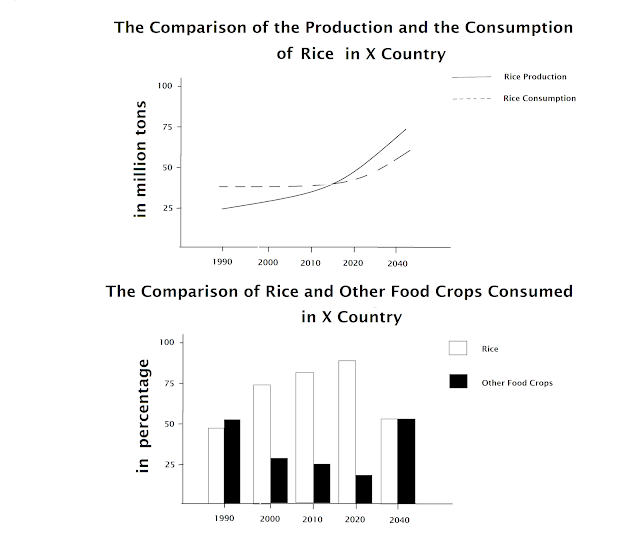In the previous lesson, we have learned how to describe bar graph and line graph in IELTS Writing Task 1. Now, we are going to learn how to describe another combined graphs, which are pie chart and table. Take a look at a sample diagram below.
 |
IELTS Writing Task 1 - Combined Graphs (Pie Chart and Table)
We are going to explain the two graphs in two separate paragraphs, so the writing structure of the combined graphs can be explained as follows:
Paragraph 1
- Introduction
- Explaining variables
- Explaining major trend
Paragraph 2
- Giving detailed information of major trend 1 (percentage, proportion, lowest/highest, increase/decrease)
Paragraph 3
- Giving detailed information of major trend 2 (percentage, proportion, lowest/highest, increase/decrease)
Paragraph 1
Introduction
As usual, we have to give a very general introduction by paraphrasing the original titles. Take a look at an example below.
- The number of college students who attend sporting events (pie chart original title)
- Various sporting events attended by college students (table original title)
- The pie chart explains the proportion of students watching sport competitions while the table compares students' attendance in such events based on gender (paraphrased title).
Explaining Variables
After introducing both graphs, we need to explain variables such as year, place, units of measurement, etc. Take a look at an example below.
There are 500 students taking part in the survey. Units are presented in percentage.
Explaining Major Trend
Here, we have to see the general pattern of the data. Because we separate the data into two different paragraphs, we can use the trend as the main idea of those paragraphs.
Major Trend 1 (pie chart)
- The pie chart indicates that the majority of students being surveyed do not go to sporting events.
Major Trend 2 (table)
- The data also shows that there are more male students attending sporting events, many of whom watch football match.
- A significant number of female students watch tennis match.
The first paragraph of the our IELTS Writing Task 1 will be as follows:
The pie chart explains the proportion of students watching sport competitions while the table compares students' attendance in such events based on gender. There are 500 students taking part in the survey. Units are presented in percentage.
Paragraph 2
In paragraph 2, we will give a very detailed explanation on the pie chart based on the first major trend. Take a look at an example below.
The pie chart indicates that the majority of students being surveyed do not go to sporting events. Of a total 500 students that participate in the survey, only one-fifth attend sporting events.
Paragraph 3
In paragraph 3, we are going to explain the tables based on the second major trend. Take a look at an example below.
The data also shows that there are more male students attending sporting events, many of whom watch football match. Of a total 57 male participants, nearly 34 of them watch football. Basketball is the second most favorite sporting events attended by 10 males. The other three sporting events are attended by a small number of male participants. As for the female population, more than a half watch tennis match. Basketball also becomes the second most favorite sporting event for females, attended by 10 individuals. Unlike their male counterpart, females do not like watching football, except for one person.
The whole writing will look like this.
The pie chart explains the proportion of students watching sport competitions while the table compares students' attendance in such events based on gender. There are 500 students taking part in the survey. Units are presented in percentage.
The pie chart indicates that the majority of students being surveyed do not go to sporting events. Of a total 500 students that participate in the survey, only one-fifth attend sporting events.
The data also shows that there are more male students attending sporting events, many of whom watch football match. Of a total 57 male participants, nearly 34 of them watch football. Basketball is the second most favorite sporting events attended by 10 males. The other three sporting events are attended by a small number of male participants. As for the female population, more than a half watch tennis match. Basketball also becomes the second most favorite sporting event for females, attended by 10 individuals. Unlike their male counterpart, females do not like watching football, except for one person.
Wordcount: 167

